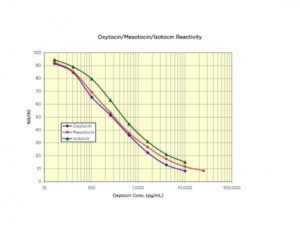Mesotocin Solution (500 ng/mL)
Personal Touch
Here to Help.
Ready to Ship
Most kits in stock.
Easy to Use
Simple protocols.
- Use For use as a calibrator in our Oxytocin EIA and CLIA kits
- For bird, reptile, amphibian, lungfish, coelacanth and some marsupial samples
Oxytocin plays an important role in the neuroanatomy of intimacy, specifically in sexual reproduction of both sexes, in particular during and after childbirth. It is released in large amounts after distension of the cervix and uterus during labor, facilitating birth, maternal bonding, and, after stimulation of the nipples, lactation. Studies have begun to investigate oxytocin’s role in various behaviors, including orgasm, social recognition, pair bonding, anxiety, and maternal behaviors. It is sometimes referred to as the “bonding hormone”. There is some evidence that oxytocin promotes ethnocentric behavior, incorporating the trust and empathy of in-groups with their suspicion and rejection of outsiders. Furthermore, genetic differences in the oxytocin receptor gene have been associated with maladaptive social traits such as aggressive behavior.
In non-mammalian species these behaviors are controlled by oxytocin-like peptides, which differ at positions 4 and/or 8. These oxytocin-like peptides include mesotocin (with an isoleucine-8) and isotocin (glutamine-4 changed to serine and arginine-8 changed to isoleucine). Oxytocin occurs in placental mammals; mesotocin occurs in amphibians, reptiles, and birds, and isotocin occurs in fishes.
Our Mesotocin solution is a perfect complement for our Oxytocin EIA and CLIA kits for those researchers studying birds, reptiles, amphibians, lungfishes, coelacanths and some marsupials. The relative binding of Mesotocin in our Oxytocin assays is shown below.



